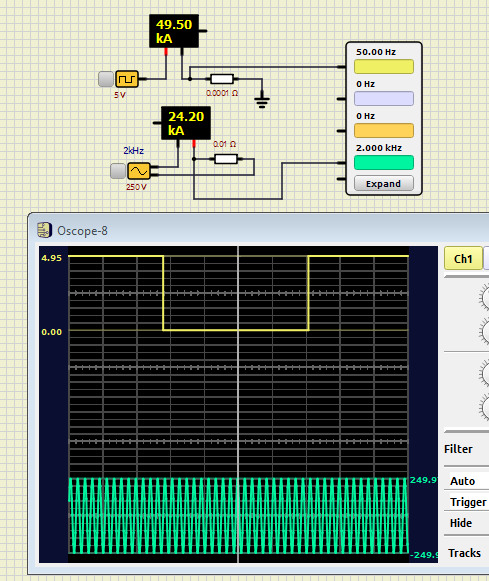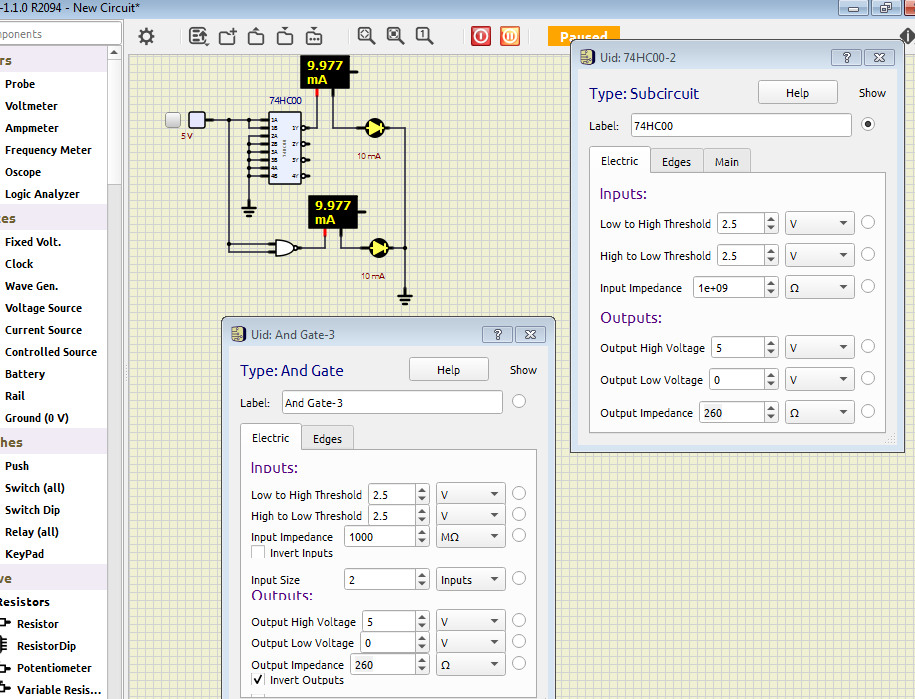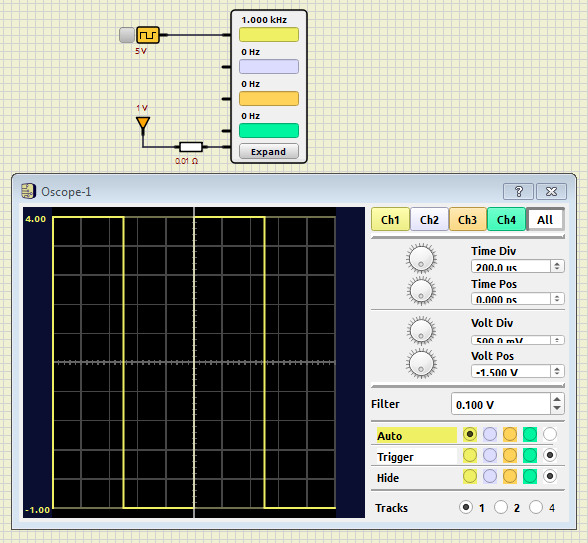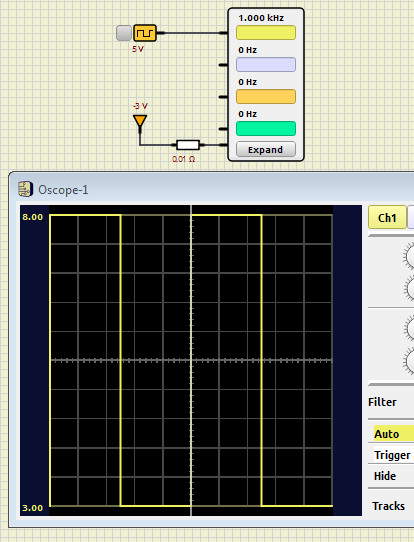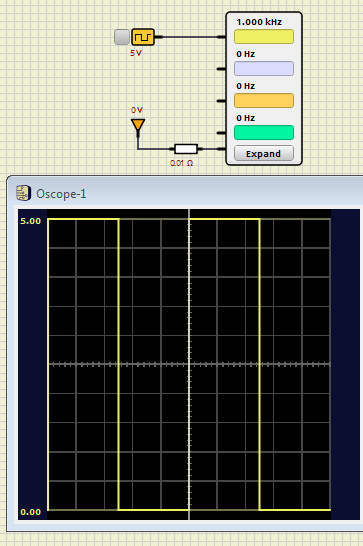About meters and input impedance
Quote from arcachofo on December 20, 2023, 6:12 pmRelated to this topic:
https://simulide.com/p/forum/topic/error-of-the-analog-mux-component-r1431-r2068/#postid-187Recently I added a new property to Oscilloscope and Logic analyzer: "Input Admittance".
Admittance is the opposite of Impedance, with unit "Siemens", but I'm using the equivalent symbol "℧" because it seems more explanatory to me: the inverse of Ohms.Admittance = 1/Impedance
Why admittance and not Impedance?
Admittance and impedance are convertible, but not in all cases, the inverse of 0 Admittance is infinite (not a numeric value) and the inverse of 0 Impedance is also infinite.
So if you want an ideal input with no connection to ground you can't set an infinite Impedance, but you can set 0 Admittance.Indeed the simulator only works with admittances internally and all impedances are converted to the corresponding admittance.
About other meters:
Voltmeter and Ampmeter are indeed resistors with a very high impedance (tiny admittance).
If not they wouldn't work properly:
Ampmeter needs to measure a voltage through a known resistance to calculate the current.
Voltmeter needs the resistance to keep both terminals at the same voltage if one of them is not connected.Probe already has a tiny admittance to ground, this one could also be configurable.
Related to this topic:
https://simulide.com/p/forum/topic/error-of-the-analog-mux-component-r1431-r2068/#postid-187
Recently I added a new property to Oscilloscope and Logic analyzer: "Input Admittance".
Admittance is the opposite of Impedance, with unit "Siemens", but I'm using the equivalent symbol "℧" because it seems more explanatory to me: the inverse of Ohms.
Admittance = 1/Impedance
Why admittance and not Impedance?
Admittance and impedance are convertible, but not in all cases, the inverse of 0 Admittance is infinite (not a numeric value) and the inverse of 0 Impedance is also infinite.
So if you want an ideal input with no connection to ground you can't set an infinite Impedance, but you can set 0 Admittance.
Indeed the simulator only works with admittances internally and all impedances are converted to the corresponding admittance.
About other meters:
Voltmeter and Ampmeter are indeed resistors with a very high impedance (tiny admittance).
If not they wouldn't work properly:
Ampmeter needs to measure a voltage through a known resistance to calculate the current.
Voltmeter needs the resistance to keep both terminals at the same voltage if one of them is not connected.
Probe already has a tiny admittance to ground, this one could also be configurable.
Quote from arcachofo on December 21, 2023, 11:42 amSeems that many people are not confortable with the parameter "Admittance".
An option would be to use the more "normal" Impedance in combination with another parameter that activate/deactivate the impedance to ground.
So I could add a checkbox: [ ] Connect to ground.
If activated then it appears a box to configure the amount of impedance:
[x] Connect to ground.
Impedance to ground [ 10] [ MΩ]
If not activated then the Admittance to ground is set to 0.This is more complicated but more intuitive for the user.
Any opinions?
Seems that many people are not confortable with the parameter "Admittance".
An option would be to use the more "normal" Impedance in combination with another parameter that activate/deactivate the impedance to ground.
So I could add a checkbox: [ ] Connect to ground.
If activated then it appears a box to configure the amount of impedance:
[x] Connect to ground.
Impedance to ground [ 10] [ MΩ]
If not activated then the Admittance to ground is set to 0.
This is more complicated but more intuitive for the user.
Any opinions?
Quote from Alex68 on December 22, 2023, 8:42 amIs it possible to set an adjustable output impedance on generators, like in real devices???
Now equal to zero ohms.
Is it possible to set an adjustable output impedance on generators, like in real devices???
Now equal to zero ohms.
Quote from Alex68 on December 22, 2023, 9:02 amFor example: on any logic you can set the output resistance - this is very necessary so as not to install, for example, current-damping resistors on LEDs in the program!
For example: on any logic you can set the output resistance - this is very necessary so as not to install, for example, current-damping resistors on LEDs in the program!
Uploaded files:Quote from arcachofo on December 22, 2023, 12:28 pmIs it possible to set an adjustable output impedance on generators, like in real devices???
Now equal to zero ohms.All sources have an tiny output impedance of 1e-14 Ω but is not configurable.
Only Battery is configurable by now.I can add a property for this.
Is it possible to set an adjustable output impedance on generators, like in real devices???
Now equal to zero ohms.
All sources have an tiny output impedance of 1e-14 Ω but is not configurable.
Only Battery is configurable by now.
I can add a property for this.
Quote from Alex68 on December 22, 2023, 12:51 pmNow the battery has internal plate resistance. It depends on the battery life. Over time, it increases and the battery fails.
Now the battery has internal plate resistance. It depends on the battery life. Over time, it increases and the battery fails.
Quote from arcachofo on December 22, 2023, 12:52 pmThe battery must be made real. Add battery capacity - ma/h or a/h.
No plans to do that by now.
The battery must be made real. Add battery capacity - ma/h or a/h.
No plans to do that by now.
Quote from Defran on December 22, 2023, 4:52 pmBoth terms are fine, although the input impedance is more known and common, the term admittance is also useful on some occasions, so, professionally thought out, it would be necessary to put BOTH or selectable.

